The world’s chocolate industry is driving deforestation on a devastating scale in West Africa, the Guardian can reveal.
Cocoa traders who sell to Mars, Nestlé, Mondelez and other big brands buy beans grown illegally inside protected areas in the Ivory Coast, where rainforest cover has been reduced by more than 80% since 1960.
Illegal product is mixed in with “clean” beans in the supply chain, meaning that Mars bars, Ferrero Rocher chocolates and Milka bars could all be tainted with “dirty” cocoa. As much as 40% of the world’s cocoa comes from Ivory Coast.
The Guardian travelled across Ivory Coast and documented rainforests cleared for cocoa plantation; villages and farmers occupying supposedly protected national parks; enforcement officials taking kickbacks for turning a blind eye to infractions and trading middlemen who supply the big brands indifferent to the provenance of beans.
When approached for comment, Mars, Mondelez and Nestlé, and traders
Cargill and Barry Callebaut did not deny the specific allegation that
illegal deforestation cocoa had entered their supply chains. All said
they were working hard to eradicate the commodity from their products.Cocoa traders who sell to Mars, Nestlé, Mondelez and other big brands buy beans grown illegally inside protected areas in the Ivory Coast, where rainforest cover has been reduced by more than 80% since 1960.
Illegal product is mixed in with “clean” beans in the supply chain, meaning that Mars bars, Ferrero Rocher chocolates and Milka bars could all be tainted with “dirty” cocoa. As much as 40% of the world’s cocoa comes from Ivory Coast.
The Guardian travelled across Ivory Coast and documented rainforests cleared for cocoa plantation; villages and farmers occupying supposedly protected national parks; enforcement officials taking kickbacks for turning a blind eye to infractions and trading middlemen who supply the big brands indifferent to the provenance of beans.
Ivory Coast deforestation
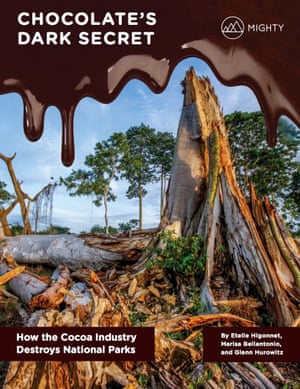
“I burned it little by little,” Sawadougou says, explaining that his cocoa needed full sun to grow. Farmers generally believe that recently deforested soil produces the biggest beans, so they remove the trees one by one, planting more cocoa as they go.
In recent years, the annual rate of deforestation inside parks has doubled, and in both Ivory Coast and Ghana, it is going twice as fast as deforestation in unprotected areas.
Cocoa is a monster that will eventually eat itself, scientists say. Farmers will miss the trees they cut and burned down for the very reason that their shade would have protected their cocoa plants from increasingly parched, dry seasons, driven by cutting down trees.
When approached for comment, most big companies acknowledged the problem of deforestation for cocoa production and said they were committed to tackling the problem.
Barry Parkin, chief sustainability officer at Mars, said: “We are committed to identifying the best ways to end deforestation and forest degradation in the global cocoa supply chain.
Nestlé said it was “opposed to the deforestation of rainforests and peatlands around the world. Nestlé regards it as one of the most serious environmental challenges facing the world.”
It noted that in 2010 it had pledged that none of its products should be associated with deforestation, and added that it supported international moves to secure zero net-deforestation by 2020.
Mondelez’s Cathy Pieters said that deforestation in supply chains was something they were actively trying to root out.
“We all recognise the urgency, and we all acknowledge the issue,” she said. “As an individual company we have probably worked the longest on this. We are exactly in the middle of that process, because of the urgency and the need for a solution.”
Hershey said it was committed to sourcing 100% certified, sustainably sourced cocoa by 2020. “We take concerns about deforestation and forest degradation very seriously,” said spokesman Jeff Beckman.
Ferrero Rocher did not respond to request for comment.
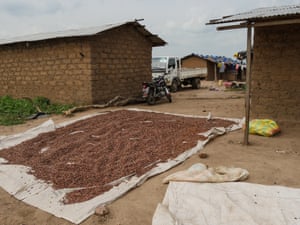
Barry Callebaut, another trading firm, pointed out its commitment to be 100% deforestation free by 2025.
It added: “For any global company/industry commitment to succeed, the boundaries of the national parks and forêt classée [classified forests] need to be redrawn or reconfirmed for an area equivalent to its original designation. The redrawn or reconfirmed boundaries need to be legally enforced by the governments.”
Many cocoa industry players – although not all – have pledged to end deforestation and forest degradation in a collective statement published in June. But this is a vague promise to try harder, while the real test will be the contents of the framework for action presented at the UN’s Convention on Climate Change in November.
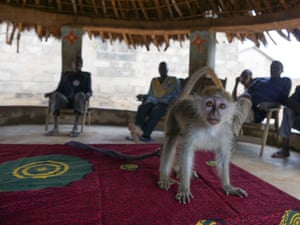
None of the companies said they would support a moratorium on deforestation cocoa, despite the fact that one on soy worked well to stop deforestation in the Amazon. Neither did they say they would commit to 100% shade-grown cocoa.
Government commitment to protecting national forests is also key. “Companies alone can’t solve this, and the government alone can’t solve this,” says Richard Scobey of the World Cocoa Foundation.
The situation inside the country’s 231 classified forests is even worse than in the parks, and this has partly to do with the different authorities that run them.
The government-funded agency protecting forests is called Sodefor; the state parks authority is the OIPR (Office Ivorien des Parcs et Réserves). Neither is doing its job. In the Marahoué park, the Guardian found repeated examples of kickbacks and racketeering by OIPR officials. In the Mount Tia classified forest, the top Sodefor official, Karma Bakary, was asked how long it would take for the forest to grow back to its former size. “One to two years,” he said. Under further questioning he upped his estimate to 10 years.
Responding to the Guardian, the Conseil Café Cacao said that it was committed to “good governance and ethics” in its activities and pointed to a programme it started, Cocoa, Friend of the Forest. There is little evidence of the programme on the ground.
Privately, activists have been warned not to touch cocoa, the backbone of the country’s economy whose vertebrae reach the highest levels of society. Those who do can get in to serious trouble. In 2004 Guy-André Kieffer, a French-Canadian journalist working on a story about cocoa and corruption, disappeared. He is believed to have been killed.
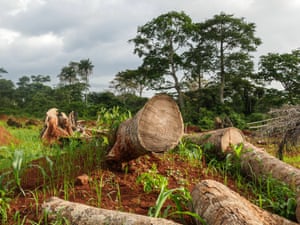
The destruction of Mount Tia started in 2004, during the first Ivorian civil war, but its much larger neighbour, Mount Sassandra forest, remained almost untouched until 2011, long after that conflict ended.
In Mount Sassandra, farmers run away at the sight of visitors, aware that their business is illegal. But these farmers are not the ones earning the vast profits to be made from chocolate: many live in poverty, often exploited and underpaid for their crop. Most cannot even afford that basic luxury in the west: a bar of chocolate.
“It’s white people who eat chocolate, not us,” one says.
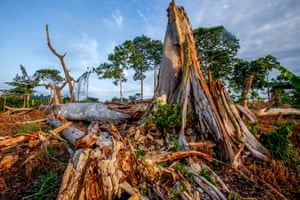
No comments:
Post a Comment